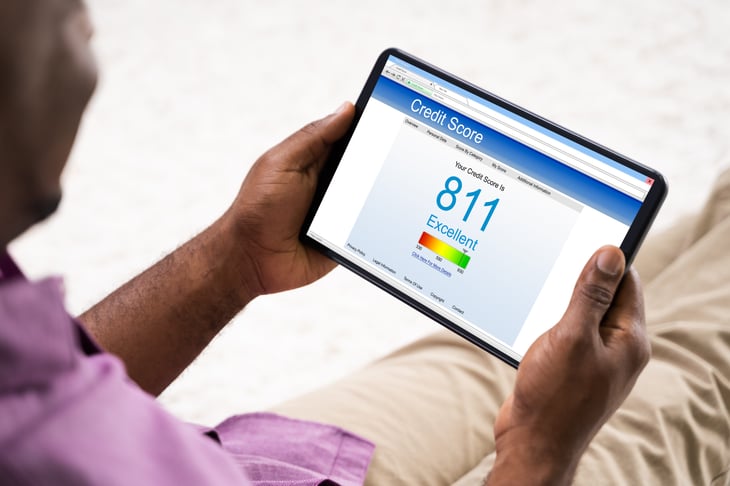
Editor's Note: This story originally appeared on The Penny Hoarder.
Put the scissors down.
Although you may be ready to cancel your credit card, it’s not as easy as simply cutting the card in tiny pieces (although that is one of the steps).
It’s important to cancel a credit card the right way, so you don’t get hit with unexpected fees or discover three months later that the number’s been stolen.
Should You Cancel Your Credit Card?

If you’ve recently paid off your credit card, it may seem like a good idea to cancel it, too — especially if you don’t intend to use it anymore. However, you should consider this move carefully, because it can have an impact on your credit score.
Why Closing Your Credit Card Account Might Be a Bad Idea

Credit cards often get a bad rap — and rightfully so, if you’re paying double-digit interest and getting hit with late fees. But for those who’ve used their credit responsibly, canceling an account can damage your credit score. Here’s how.
Payment history

Your payment history accounts for approximately 35% of your credit score. Making credit card payments on time every month positively contributes to this.
Eliminate the card, and you reduce the number of accounts that count toward your on-time payments.
Credit utilization

This may be the strongest argument for holding onto your credit card.
The credit utilization ratio represents how much of your available credit you actually use. To calculate yours, divide what you owe across all your credit accounts (think: credit cards and other credit lines like a home equity line of credit) by the total credit limits for those accounts.
Closing a credit card could send your ratio up — way up.
For example, let’s say you had two credit cards — each with a credit limit of $8,000. On the first card, you had a balance of $4,000; on the second card, you had a balance of $1,000. Your credit utilization ratio was $5,000/$16,000 = 0.3125 or 31.25%
Most experts recommend a credit utilization ratio of 30% or less, so your score is not great.
Then you paid off the second credit card’s balance, which improved your ratio to 25% ($4,000/$16,000).
But if you closed the second credit card account, your credit utilization ratio would skyrocket to 50% ($4,000/$8,000).
Considering credit utilization counts for approximately 30% of your score, it’s a wise idea to keep an account open if you want to keep your usage ratio low.
Length of credit history

Closing a credit card that you’ve had for years will lower the average age of your accounts in your credit history, which contributes approximately 15% to your score. And you can’t replace history easily — that only comes with holding onto an account over time.
Why Closing Your Credit Card Account Might Be a Good Idea

So what would be a good reason to close a credit card account? Losing the fees.
Many credit cards charge an annual fee, and if you’re not using the card, it doesn’t make much sense to continue paying a fee.
How to Cancel a Credit Card

After weighing the pros and cons, if you still want to cancel your credit card, we have a step-by-step guide for doing it in a way that will help save you from forking over extra fees and protect you from having your old account number stolen.
1. Pay Off or Transfer the Remaining Balance

If you still have a credit card balance, the first thing you need to do is get it down to zero. You can do that either by paying it off or transferring the balance to another card.
Want to close a card when it still has a balance? You can ask your credit card issuer to freeze your account so you can’t make any new charges, but you’ll have to keep making payments until the balance is $0.
Next, you’ll need to cancel any recurring payments you have set up for the account. It’s best to gather at least a year’s worth of past statements to review what accounts are linked to your card. That way you won’t be stuck with a late fee because your annual home insurance premium didn’t get paid.
Even if you think you’ve remembered every account linked to the card, it’s best to wait at least a couple of months and as much as a year to avoid surprises.
After you’ve paid off the remaining balance, you’ll want to continue checking your statements for the next couple of months to avoid any residual interest you may have accrued.
2. Use Up Your Rewards

If you have rewards points on your card, you should use those before canceling the card. This is sometimes easier said than done — if you have a travel rewards credit card and don’t have plans to travel anytime soon, you might think the points are worthless. However, some issuers are extending the time before your points expire. You can use the points now to book a future trip.
For example, with cards that allow you to trade in points for a specific airline or hotel travel reward program, you may be able to continue to be a part of the program (and use those points) even after the card is closed.
Cards with flexible points may offer a cash-back value or you may be able to transfer the points to another card that uses the same program or spend at least some of the points on gift cards instead.
The only way to know for sure: Review your credit card rewards agreement.
The point is, you may not be able to redeem points for what you originally intended, but you’ll lose any leftovers when you close the account.
3. Contact Customer Service to Close the Account

Are you strong enough to say no? And should you?
After you’ve paid off your balance and used up your rewards, you’re ready to close the account, which means contacting your credit card issuer.
Those companies don’t like to lose customers — especially good ones who pay their bills on time — so don’t expect them to give up easily.
The representative you speak to will likely try to convince you to stay by telling you that you’re qualified for bonus rewards, qualify for a lower interest rate or can have your annual fee waived.
If you’re canceling the card simply because of the annual fee, this potential offer could be enough of a reason to call the issuer.
But if you’re absolutely certain you want to close the account, a couple of firm, “Thanks, but no — I’m certain” responses should shut them down.
Before you hang up, request written confirmation that the account is closed with a $0 balance. This helps prevent nasty surprise fees or damage to your credit score for non-payment. When you receive the letter, keep it in your files in case a debt collector tries to convince you years later that you owe on zombie debt.
If you don’t receive the confirmation letter within a few weeks, send your own written cancellation letter.
Include your name, address and account number, and state in the letter that you would like your account closed and for the company to confirm you have a $0 balance — send it by certified mail to confirm the company received the letter.
4. Check Your Credit Report

Remember to check your credit report for proof that the company closed the account with a $0 balance.
You can — and should — get your credit report every year from the Big Three credit reporting agencies: Experian, Equifax and TransUnion. You can order yours for free every 12 months through the website annualcreditreport.com.
Make sure each of the reports lists your credit card account as closed and the account status as paid — again, you may want to wait a few weeks (or months) to ensure the credit card company reported the account was closed.
5. Cut Up the Old Card

When you destroy your credit card, be sure to slice it so that neither your name nor your account number appear on a single piece and that you cut through the magnetic strip. (You can also use most shredders to get the desired effect). This helps ensure no unsavory types can dig the card out of the trash and attempt to use the old account.






Add a Comment
Our Policy: We welcome relevant and respectful comments in order to foster healthy and informative discussions. All other comments may be removed. Comments with links are automatically held for moderation.